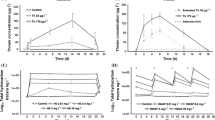Abstract
Creosote has been used extensively as an industrial wood preservative for the protection of marine pilings, railway ties, and utility poles and is a common source of polycyclic aromatic hydrocarbons (PAHs) into aquatic environments. At present, there is little information by which to judge the potential for creosote leached from impregnated pilings to cause toxicity to biota in aquatic environments. The objective of the current study was to assess the effects of creosote on zooplankton and phytoplankton populations in freshwater microcosms in relation to changes in the concentration and composition of PAHs leached from creosote-impregnated Douglas fir pilings during an 83-day exposure period. The study consisted of single microcosms containing one half, one, two, three, four, and six treated pilings. Two microcosms that received untreated pilings were used as controls. The total surface area of pilings in each microcosm was normalized by adding the appropriate number of untreated pilings. Samples were collected periodically between −14 and 83 days pre- and post-exposure to determine aqueous concentrations of 15 priority PAHs and to assess the response of zooplankton and phytoplankton communities. Plankton community response to creosote was analyzed using principle responses curves. Peak aqueous concentrations of ΣPAH occurred at day 7, ranging from 7.3 to 97.3 μg/L. Zooplankton abundance decreased in all microcosms after introduction of the impregnated pilings, with the magnitude of response varying as a function of aqueous creosote concentration. Using inverse regression, a no-observed-effect concentration for the zooplankton community of 11.1 μg/L was estimated. In contrast, algal abundance and diversity increased in all treatments between 7 and 21 days and attained levels up to twice that in control microcosms. This trend most likely reflected decreased grazing pressure because of the decrease in zooplankton populations, but it may also have reflected growth stimulation resulting from exposure to various constituents within the creosote mixture. Our results indicate that creosote leached from impregnated pilings deployed under typical conditions (e.g., wharves) may cause transient toxicity to benthic or limnetic communities shortly after deployment, but this likely poses few long-term risks to aquatic freshwater plankton communities.
Similar content being viewed by others
Author information
Authors and Affiliations
Rights and permissions
About this article
Cite this article
Sibley, ., Harris, ., Bestari, . et al. Response of Zooplankton and Phytoplankton Communities to Creosote-Impregnated Douglas Fir Pilings in Freshwater Microcosms. Arch Environ Contam Toxicol 47, 56–66 (2004). https://doi.org/10.1007/s00244-004-3129-7
Issue Date:
DOI: https://doi.org/10.1007/s00244-004-3129-7




